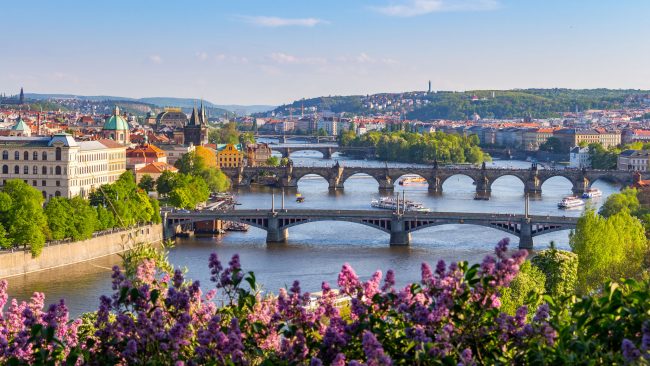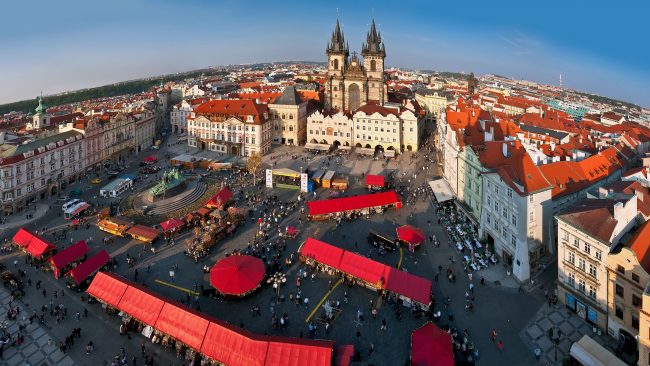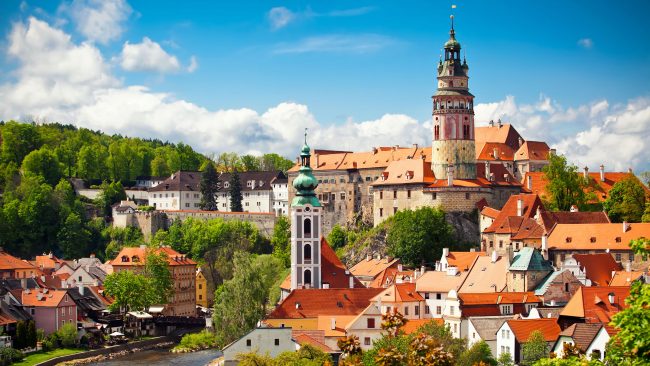Tourism in Prague increases every year due to the beauty of its attractions. Here you will find a travel guide to know all the aspects of the capital of the Czech Republic, known as "the city of a hundred towers": recommendations, tourist places, traveling with children, etc.
Below you have an index with all the points that we are going to deal with in this article.
Article Index
- 1.
- 2.
- 3.
- 4.
- 4.1.
- 4.2.
- 4.3.
- 4.4.
- 4.5.
- 4.6.
- 4.7.
- 4.8.
- 4.9.
- 4.10.
- 4.11.
- 5.
- 6.
- 7.
- 8.
- 9.
General Information
Prague is the capital of the Czech Republic, a country that until 1993 was part, together with Slovakia, of Czechoslovakia. During its history, it has been subject to the Kingdom of Bohemia, the Austro-Hungarian Empire and until 1989 to the Soviet Union. It is in 2004 when it enters the European Union.
The country is located in Central Europe, between Germany, Poland, Slovakia and Hungary. Within the Czech Republic (or Czech Republic), Prague is situated slightly in the northeast, being located practically in the center.
Despite being in the European Union, the official currency of the country is still the Czech crown. However, you can travel with euros, since in Prague you will find many exchange houses and even some tourist shops accept them.
If you decide to exchange money in the city, you should only go to official exchange houses and not to do it on the street, since sometimes there are scams to tourists due to their misinformation.
In Prague we find five tourist offices. Two of them are located at the airport and the other three in the city center. The easiest to locate is the one found in the Old Town Square (Old Town Square.
In terms of cost, the Czech Republic is not an expensive country, although Prague has higher prices due to tourism. Still, they are very good prices compared to other European cities.
If you are going to spend three or four days in the city and you don't know how much money to bring, € 150-200 per person is enough, regardless of accommodation.
Many people decide to take a combined trip between several cities. The most popular is the circuit between Prague, Vienna and Budapest, being able to add Zagreb or Zurich to this tour. You can find many offers on the Internet.
It is possible to travel cheaply from German cities like Berlin, Frankfurt or Innsbruck thanks to the train and the bus. Another option is to take an organized trip between Prague, Warsaw and Wroclaw, even a grand tour of Europe that also includes Italian cities such as Florence or Roma.
The opinions of tourists who have already visited Prague are usually very positive thanks to the services provided for travelers and the prices of the city. In addition, all say they are amazed with the beauty of it.
However, visiting this city has some drawbacks, such as the overcrowding of tourism, which is concentrated in a relatively small area, a fact that can be a bit overwhelming in high season.
If you are looking to find out about this city from Spain, in Madrid There is a Czech Republic Tourist Office at Avenida de Pío XII, 22. In Barcelona There is no information center, but there is the Consulate, which is located at Travessera de Gràcia, 50.
It's remarkably easy to find your way around Prague, as it's bisected by the Vltava River. In this tourist map you can see the different districts of the city, as well as the main attractions.
Requirements and documentation
If you are from a country belonging to the European Union, such as Spain or Portugal, to travel to Prague you will only need an identification document, that is, DNI, NIE or passport.
From many other countries it is requested passport, and if the stay is going to be less than 90 days, a visa is not necessary. Among these countries, Mexico, Venezuela, Chile, Colombia and Argentina stand out.
Children and babies can travel to the country, but they must have their own documentation. If minors are not accompanied by their parents and do not have a passport, they must carry an authorization that has been formalized with the authorities.
For travel with dog, they must have a veterinary passport stating that they have been vaccinated against rabies between one month and one year before the trip, as well as an identifying chip or tattoo.
Prague is a good city to visit with dogs, as they can use public transport. In addition, they are welcome in a large number of establishments, where they will even serve water, and it is easy to find a hotel pet friendly.
When to go
The best time to go to Prague is in spring, a time when the climate begins to improve and trees and plants to flourish. In addition, in March they begin to set up the Easter markets.
The end of summer, especially September, is also a great option, as there are more attractions open, such as the Castle Gardens. July and August should be avoided, months when the city is packed with tourists.
If you travel in December you can enjoy a special Christmas or New Year's Eve, since Prague has a very good atmosphere at that time. January and February are too cold months, since in winter it usually snows and the temperatures are very low.
Tourists usually take advantage of the holidays to visit the city, so on dates such as the May or November holidays traveling on your own is more difficult, since the prices of flights and hotels tend to rise.
What to see and do
Prague stands out for its architecture and the charm of its different neighborhoods. The Top 10 of the best corners and the most visited places are:
Old Town Square
It is the center of the city. In the Old Town Hall building is the Astronomical Clock, in which visitors gather every hour to see the show that it performs.
It is the favorite place for tourists, where a market is set up on special occasions, such as Christmas and Easter.
Charles Bridge
It is the oldest bridge in Prague and has a length of 516 meters. It is adorned by no less than thirty sculptures, so it can be considered a true open-air museum.
Prague Castle
It is considered the largest castle in the world. Inside you will find the Cathedral of San Vito, as well as the Callejón del Oro, the place where the writer Franz Kafka lived.
Its main entrances are guarded by the official guard, which changes components every hour on the hour.
Jewish quarter
In the same way as the Spanish Synagogue, the Jewish cemetery stands out, which concentrates around 12.000 tombstones in a considerably reduced space.
This district has suffered isolation and repression throughout its history. However, currently the most expensive shops in the city are concentrated, especially on Calle Paris.
Wenceslas Square
It is the center of the modern part of the city. Its length is such that it looks like an avenue, and there are even two metro stops on it. Here are concentrated shops, stores and restaurants.
Also, at the top of the square we find the National Museum, considered the most important in the country.
Powder Tower
This Gothic-style tower was built in the XNUMXth century and separates the old city from the new city. It receives this name because in the XNUMXth century it was used as a deposit of gunpowder.
Malá Strana neighborhood
Located at the foot of the Castle, it is made up of well-preserved palaces and old houses. To get there from the historic center, you must cross the Charles Bridge.
In this area is the narrowest alley in the city, which is only 50 centimeters wide. Therefore, to avoid collisions between people, there is a traffic light at each step.
Dancing House
It occupies the site of a building destroyed during a bombing in World War II. It was given that name, which in Spanish means "Dancing Building", because its design is inspired by two dancers.
Mount Petřín
This place can be reached in around 10 minutes by tram from the city center. It is a hill that can be climbed both on foot and by funicular.
At its top is the Petřín Tower, which is reminiscent of the Eiffel Tower. From the top of it there are magnificent views of the city.
rudolfinum
It is a large neo-Renaissance building and the largest and most important auditorium in the country, where classical music concerts are held daily. Another important auditorium is the National Theater.
Other attractions
It is also possible to do adventure tourism, since there are numerous bicycle tours in the city. In its surroundings you will also have the option of riding a balloon and even piloting a small plane.
For those who prefer alternative tourism, the sculptures of the artist David Černý are scattered throughout the city, which have controversial themes and leave no one indifferent. If you like graffiti, the John Lennon wall is your place.
Despite the fact that the majority of the Czech population is atheist, religious tourism has an important space in the city, since in the Church of Santa María de la Victoria there is the figure of the Infant Jesus of Prague, which is known at the level world.
There are some places near Prague that are worth visiting, such as Cesky Krumlov, Karlovy Vary, Kutna Hora or Pilsen. The best choices to get there are the train or the agency buses Student Agency. Both alternatives claim to be cheap and punctual.
Itineraries
There are numerous tourist buses, most with the system hop on hop off, of which you can get on and off as many times as you want. They are equipped with audio guides in Spanish.
Also, the best option if you are going to spend a weekend of 2 or 3 days is to visit the places that we have listed above. In the evening, you can have a drink in one of the many jazz venues or try one of the typical Czech beers offered by the city's bars.
If you are going to be 4 days or more, the ideal is to add an excursion to a nearby place. The most visited are Karlovy Vary, a spa town known for its fountains, and Cesky Krumlov, a small fairy-tale town.
The most romantic plans to do as a couple are to make a Boat tour by the Vltava, where you can even dine, climb the Petřín Tower to enjoy the views and attend a concert or opera.
The favorite corner for teenagers is the John Lennon wall, since it is allowed to write and paint. For the little ones, you can find the Isla de los Niños in the river, equipped with playgrounds and sports facilities.
Also, if you want to attend a show with the whole family, we recommend going to see a Black Theater, in which they play with light and shadow to create incredible effects.
Most of the tourists who decide to travel to Prague are over 55 years old. For them there are also a good number of activities, as well as Turistic guides that show visitors the best of the city.
How to get
Due to the different possibilities that are offered, it is feasible to travel cheap to reach this destination. The most comfortable means of transport to get around is the plane.
From Spain the main airlines that fly to Prague are Ryanair, Iberia and Vueling. From Barcelona o Madrid there are flights without scales. From other cities like Valencia it is necessary to make a stopover.
Most of the countries of South America they have flights to this destination, but also with stopovers. We can find attractive all-inclusive flight + hotel offers in different travel agencies.
If you are in one of the neighboring countries, such as Germany or Austria, you can also reach the city by train. In addition, if you plan to visit several European countries with this means, it is best to use Interrail.
The roads connect all parts of the country, but they are not in good condition if we compare them with those of other countries. On the other hand, if you arrive by car, you should know that the maximum speed on the country's highways is 130 km / h.
For those who are used to traveling by motorhome, there it is common to park them somewhere camping o auto camp, places where you can park and also have different services.
Where to eat
In this destination you will find many options where to eat. From traditional Czech restaurants to the most famous food chains, passing through establishments around the world, highlighting the Japanese.
The places in the historic center are the most touristy. Although they do not tend to have abusive prices, there is quite a difference with restaurants that are further from the great attractions.
Some of the most typical dishes are g, the knuckle and the duck, all of them accompanied by sauce and dumplings, a kind of cooked dough balls made of flour, bread or potatoes.
A sweet that you will find in a large number of establishments in the center is called Trdelnik, which is made with flour and roasted over the fire. It can be served with sugar, chocolate, ice cream or fruit.
You cannot leave Prague without trying its famous beer. The Czech Republic is the country that consumes the most this drink in the world, so beer tourism is not far behind. Some restaurants even make their own.
Appropriate clothing
The appropriate clothing to travel to this area depends on the time of year in which we do it. Whatever the season, it is advisable to bring an umbrella or a raincoat, since when it rains it tends to do so with intensity.
In July and August it is usually hot, so it is advisable to wear fresh clothes, but always with comfortable shoes, since the entire old town of Prague is pedestrianized and there is usually a lot of walking.
In the winter months it should be worn Thermal clothing or insulation from the cold, as well as gloves, scarf and hat, since the average temperature during this period is zero degrees.
In spring and autumn the temperatures are more moderate, but the coat is usually essential. Also, they are the rainiest seasons, so it is likely that it will rain during the trip.
Language
The official language of the country is Czech. Fortunately, in the tourist places of Prague they communicate with tourists usually in English. If we move away from the tourist area, it is more difficult to communicate.
It is also possible to travel to Prague without knowing English, since due to the number of tourists from Latin America and Spain, in some shops and restaurants they know Spanish or have a menu in this language.
Some useful phrases in English to use while traveling are:
- How much does it cost?: How much is it?
- You can help me?: Can you help me?
- Thank you: Thank you
- Where is the bathroom?:Where is the toilet?
- Where is ….?: Where is….?
Czech is a complicated and difficult language to pronounce. If you still want to give it a try, some of the easiest words are Hello (ahoj), please (Please) Y Thank you (Thanks).
This article has been shared 77 times. We have spent many hours collecting this information. If you liked it, share it, please:




































